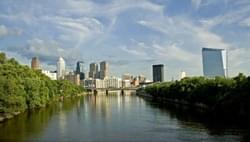




From McCormick, Taylor and Assoc. Planners and Engineers
The tables show estimates of time needed to maintain the Montgomery County, PA, trail.

The following chart provides an estimated projection of the hours required to maintain approximately one mile of the Shared Use Path for the Townships and PENNDOT. The estimated hours are based on hours actually worked at the 11.5-mile Schuylkill Trail in Montgomery County, with some modifications. Please note that all projections are estimates and intended to promote discussion. The actual maintenance hours required may vary and should be worked out by each municipality.
Maintenance costs for the Schuylkill River Trails and Greenways, management planning, railtrail corridor study, recreation path system, Pennsylvania Montgomery County, linear National state park, develop process public input, adjacent landowner, state federal agency partnership, Forest Service Accessibility Guidelines, FSTAG, American federal right-of-way abandoned, hiking, bicycle, pedestrian, study, link system connect
| Maintenance Categories* | Jan | Feb | Mar | Apr | May | June | July | Aug | Sep | Oct | Nov | Dec | Municipal | PENNDOT |
|---|---|---|---|---|---|---|---|---|---|---|---|---|---|---|
Mowing | 0.0 | 0.0 | 0.0 | 3.1 | 6.8 | 3.6 | 3.9 | 5.6 | 3.3 | 2.5 | 0.0 | 0.0 | 28.8 | |
Trimming/Pruning1 | 0.9 | 0.0 | 4.1 | 2.8 | 8.5 | 4.1 | 3.5 | 7.1 | 4.0 | 3.5 | 1.3 | 0.2 | 40.0 | |
Safety/Security | 0.6 | 0.5 | 0.6 | 5.4 | 3.4 | 3.0 | 4.2 | 6.7 | 1.4 | 2.4 | 5.3 | 0.2 | 33.6 | |
Trash2 | 0.3 | 0.3 | 0.8 | 1.8 | 0.7 | 0.8 | 0.9 | 0.7 | 1.0 | 0.9 | 0.8 | 0.4 | 9.4 | |
Erosion/Stabilization | 0.7 | 0.6 | 1.8 | 2.0 | 1.0 | 0.0 | 1.0 | 1.5 | 5.6 | 6.4 | 2.3 | 1.2 | 24.1 | |
Storm3 | 0.8 | 3.7 | 1.5 | 1.2 | 0.5 | 1.2 | 0.4 | 0.3 | 0.7 | 0.3 | 0.3 | 0.2 | 11.0 | |
Totals | 3.2 | 5.1 | 8.8 | 16.4 | 20.8 | 12.8 | 14.0 | 21.9 | 16.0 | 16.0 | 10.0 | 2.0 | 118.1 | 28.8 |
Total Hours Per Mile
Descriptions
Notes:
1. Hours reduced by half from County estimate because no trees will overhang the trail in the foreseeable future.
2. Hours reduced by half from County estimate because no trash receptacles will need to be emptied
3. Hours reduced by half from County estimate because no plowing of path is requested. Since no trees will overhang the trail in the foreseeable future, fallen limb removal will be minimal
Trash: Approximate maintenance hours estimated for a 1-mile length of the US 202, Section 711 Shared Use Path, based on maintenance hours from the Schuylkill River Trail. The paved macadam trail will be 14 feet wide.
Year 2000 Maintenance Hours for the Schuylkill River Trail, Montgomery County: The paved macadam trail is 11.5 miles long and the width varies from 12 to 16 feet.
| Maintenance Categories | Jan | Feb | Mar | Apr | May | June | July | Aug | Sep | Oct | Nov | Dec | Year Total |
|---|---|---|---|---|---|---|---|---|---|---|---|---|---|
Mowing | 0.0 | 0.0 | 0.0 | 37.5 | 81.3 | 43.0 | 47.0 | 67.5 | 40.0 | 29.5 | 0.0 | 0.0 | 345.8 |
Trimming/Pruning | 21.0 | 0.0 | 98.0 | 67.0 | 204.0 | 99.0 | 85.0 | 170.0 | 96.0 | 85.0 | 31.0 | 4.0 | 960.0 |
Safety/Security | 7.0 | 6.0 | 7.0 | 65.0 | 40.5 | 36.0 | 50.0 | 80.0 | 17.0 | 29.0 | 64.0 | 2.0 | 403.5 |
Trash | 7.0 | 8.0 | 19.0 | 44.0 | 16.0 | 20.0 | 22.0 | 16.0 | 24.0 | 21.0 | 19.5 | 9.0 | 225.5 |
Erosion/Stabilization | 8.0 | 7.0 | 22.0 | 24.0 | 12.0 | 0.0 | 12.0 | 18.0 | 67.0 | 77.0 | 28.0 | 14.0 | 289.0 |
Storm | 18.0 | 89.0 | 36.0 | 29.0 | 11.0 | 29.0 | 10.0 | 8.0 | 17.0 | 6.0 | 6.0 | 4.0 | 263.0 |
Misc. | 22.0 | 16.0 | 36.0 | 32.5 | 25.0 | 25.0 | 21.0 | 30.0 | 20.0 | 51.0 | 18.0 | 6.0 | 302.5 |
Totals | 83.0 | 126.0 | 218.0 | 299.0 | 389.8 | 252.0 | 247.0 | 389.5 | 281.0 | 298.5 | 166.5 | 39.0 | 2789.3 |
*Descriptions
Mowing = Mowing of grass, with riding or walk behind equipment
Trimming/Pruning = Vegetation control rather than mowing. Includes trimming, cutting and pruning of weeds, vines, brush and trees. Also includes spraying or blowing
Safety/Security = Safety and Security. Includes all maintenance of gates, bollards, signs, 911 call boxes and fences
Trash = Removal of trash from park-owned receptacles; pick up/disposal of any trash or debris on trail or trail edges
Erosion/Stabilization = Any work related to erosion and/or stabilization on trail. Includes drainage, pavement/pothole repairs, vegetative planning, seeding, etc.
Storm = Any maintenance directly resulting from storm damage. May include cleaning of any debris on trail, cutting/removal of any downed trees or branches, and snow/ice removal. NOTE: There may be some overlap of work tasks between storm damage and erosion and stabilization.
Misc. = Maintenance work not directly falling into any categories above. May include administrative paperwork, meetings/site reviews with adjacent property owners, construction/utility companies or general trail inspections, and travel time to and from trail.